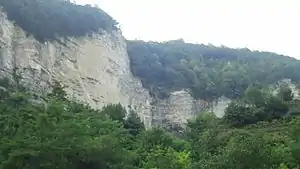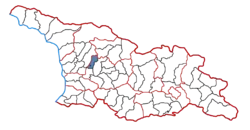Khoni Municipality
Khoni (Georgian: ხონის მუნიციპალიტეტი) is a district of Georgia, in the region of Imereti. Its main town is Khoni.
Khoni Municipality | |
|---|---|
 | |
 Flag  Seal | |
 Location of the municipality within Georgia | |
| Country | |
| Region | Imereti |
| Capital | Khoni |
| Government | |
| • mayor | Lado Jurkhadze |
| Area | |
| • Total | 429 km2 (166 sq mi) |
| Population (2002) | |
| • Total | 23,570 |
| Time zone | UTC+4 (Georgian Standard Time) |
The territory of Khoni municipality is part of the historical kingdom of Colchis. The origin and development of the Khoni is related to the trade-caravan routes passing through the area. The abutment of “Bumbua Bridge” on the Tskhenistkali river is preserved to the present day. Here, in 65 BC the Roman commander Pompey passed through and built a lifting bridge.
History
The remains of ancient smeltings are found in Kveda Kinchkha. There is also found a gold money of ancient times, the stater of king Ake (BC. SEC. III century), in Khoni there are 1270 pieces of "Colchian white" coins, Byzantine or Turkish coins. Late Bronze Age hill settlements- "Gorikebi" - are found in Khoni, Little Jikhaishi, Kutiri, Ghvedi. The population still finds various items of bronze fighting, agricultural, cult-ritual purposes and copper ingots. In the first centuries of Christianity the churches of the first martyr were built in: Khoni, Gelaveri, Kveda Kinchkha and Khidi. In the Middle Ages, the territory of the municipality was the property of the King. During the Russian conquest of the kingdom of Imereti and Russian rule, the territory of the municipality was part of Vake Mazra and the Daba Khoni- center of Mazra. Since 1846, this territory merged with Kutaisi Governorate.[1]
Historical Monuments
The ancient historical monument which preserved on the territory of Khoni Municipality is BC 65 years old “Bumbua” or Pompey Bridge in the village of Khidi. There are two Early Feudal Age fortresses in the village of Matkhoji. Khoni Church is notable- VIII-XI century St. George church in Khoni. The medieval settlement of Kibula is found in the village of Kveda Kinchkha. Here are the churches of Saviour and St. George, Tareshi Church and burial vault. XVII century Gvashtibi Fortress and the church in Gvashtibi; Ghvedi Fortress in the village of Ghvedi. In the territory of the village of Kveda Gordi are the XVIII century Rekhi and Veli Fortresses. In the same village there are monuments of the XIX century on the estates belonging to Dadiani: Forest-Park, Kari Church, historical sources.[2]
On the territory of the municipality historical monuments are also preserved in the villages:
- Bangveti-X-XI centuries church
- Udzlouri- 1319 Church of Saviour
- Akhalsheni- medieval Mukhurisi Fortress
- Sukhcha- medieval Church of the Mother of God
- Nogha- medieval “Ukimerioni” Fortress and Church
- Khidi- late medieval former church of Obuji
- Patara (little) Jikhaishi- 1790 and 1897 St. George and Saviour Churches
- Gelaveri- XVIII Century Marine Church
- Matkhoji- 1864 and 1872 St. Basili and St. Nino Churches
- Kutiri- St. George church, 1872
- Khoni- pedagogical seminar, 1881
- Satsulukidzeo-XIX century former church of Kvirike and Ivlita
- Dzedzileti-Archangel Church
See also
- Districts of Georgia (country)